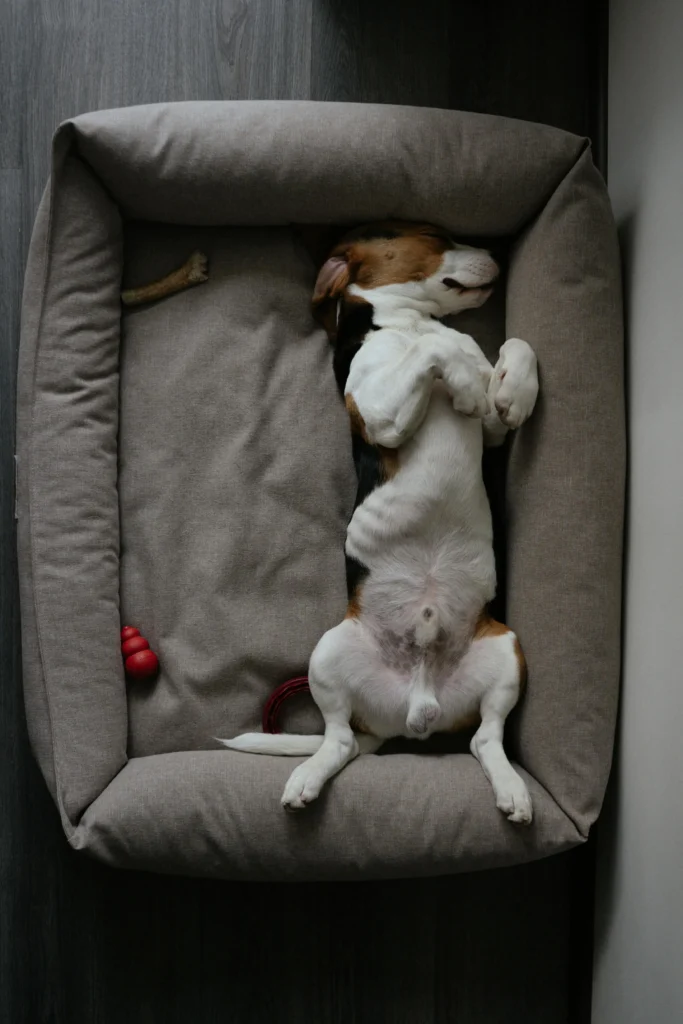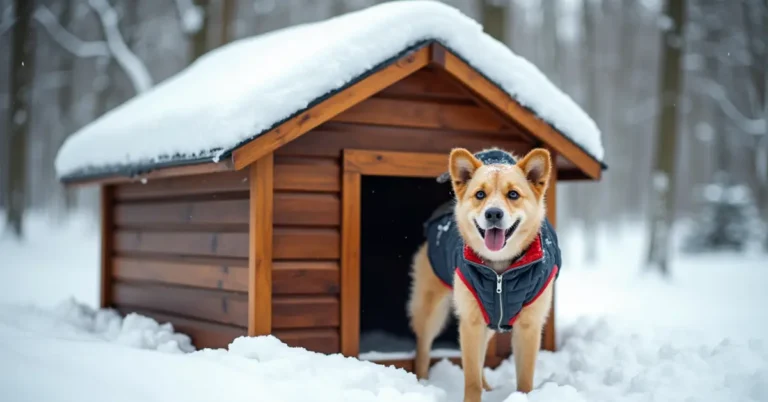When it comes to taking care of your dog, choosing the right dog beds can be just as important as selecting their food. A good dog bed can help improve your pet’s health, comfort, and even happiness. But how do you know which one is right for your furry companion? In this article, we’ll explore 15 must-know tips to help you pick the best dog beds for your dog, while also learning how a proper bed affects their overall well-being.
Let’s dive right in and explore how to pick the best dog beds while keeping your pup’s health, comfort, and safety in mind!
Table of Contents
Why a Quality Dog Bed is Essential for Your Dog’s Health
Before we get into the different types of dog beds, let’s start by understanding why a quality dog bed is important . Just as you wouldn’t sleep on a hard floor or an uncomfortable couch every night, your dog deserves a comfortable and supportive place to rest. A good dog bed can have a profound impact on your dog’s overall health and well-being.
Improved Joint Support and Posture
A quality dog bed can improve your dog’s posture and support their joints, especially in older dogs. This is crucial for preventing joint pain and aiding in better sleep.
Enhanced Immune System
Adequate sleep is vital for your dog’s immune system. When your dog gets quality sleep, their body can repair and regenerate tissues, build bone and muscle, and strengthen their immune system. A comfortable dog bed ensures your dog gets the restful sleep they need to stay healthy and resilient.
Better Mood and Reduced Stress
Sleep plays a significant role in regulating your dog’s mood and reducing stress. A well-rested dog is generally happier and less anxious. This can lead to better behavior and a stronger bond between you and your pet.
Increased Energy Levels
Quality sleep directly impacts your dog’s energy levels. A dog that sleeps well will be more energetic and active during the day, making them more enjoyable to be around and easier to train.
Temperature Regulation
A good dog bed can help keep your dog warm during cold nights and cooler in hot weather. This temperature regulation is essential for maintaining your dog’s comfort and preventing illnesses related to extreme temperatures.
Designated Safe Space
A quality dog bed provides a designated space where your dog feels safe and secure. This sense of security can reduce anxiety and stress, leading to a more relaxed and content pet.
Hygiene and Health
Keeping your dog off dirty or cold floors reduces the risk of illness. A clean and comfortable dog bed is easier to maintain than a dirty floor, ensuring your dog stays healthier.
A high-quality dog bed can prevent joint pain, aid in better sleep, enhance the immune system, improve mood, increase energy levels, regulate temperature, provide a safe space, and maintain hygiene. If you’re like most dog owners, you want your furry friend to be as happy and healthy as possible, and choosing the right dog bed is a key part of that.

Types of Dog Beds: Which One is Right for Your Pup?
There are many different types of dog beds available, each offering unique benefits. Knowing your dog’s needs and preferences will help you pick the best option. Here’s a look at some of the most popular choices, including the materials commonly used in each.
1. Orthopedic Dog Beds
If your dog is getting older or suffers from joint issues like arthritis, an orthopedic dog bed might be the perfect solution. These beds are made with high-density foam, often memory foam, which conforms to your dog’s body. This provides excellent support and relief for dogs with sore joints or back problems. Orthopedic beds are typically covered in durable materials such as canvas or thick cotton to ensure longevity.
Materials:
- Memory Foam: Provides excellent support and relief for joints.
- Canvas or Cotton Covers: Durable and easy to clean, these materials are ideal for dogs that tend to chew or get dirty.
- Hypoallergenic Fabrics: Some orthopedic beds come with hypoallergenic materials to cater to dogs with allergies or skin sensitivities.
Bonus Tip: For an added layer of comfort, you might want to look into heated orthopedic beds. These beds can help dogs with arthritis feel warm and reduce stiffness in their joints.
2. Memory Foam Dog Beds
Memory foam dog beds offer a similar benefit to orthopedic ones but focus more on comfort than medical relief. Memory foam conforms to your dog’s shape, providing a snug and cozy fit that’s perfect for dogs who love to feel wrapped up in warmth. These beds are often covered in soft materials like fleece or plush cotton.
Materials:
- Fleece: Soft and warm, fleece is ideal for colder climates or dogs that love to snuggle.
- Plush Cotton: Provides a luxurious feel and is often breathable, making it suitable for dogs that tend to overheat.
- Microfiber: A synthetic material that is easy to clean and maintain.
3. Raised Dog Beds
Raised or elevated dog beds are a fantastic option for outdoor use or warmer climates. These beds sit off the ground, allowing air to circulate around your dog, keeping them cool during hot weather. They’re also helpful for dogs who tend to get dirty or wet, as raised beds keep them away from the ground.
Materials:
Durable Nylon or Polyester: These materials are weather-resistant and easy to clean.
Waterproof Fabrics: Commonly used in raised beds to protect against moisture and dirt.
Mesh Materials: Allow for excellent airflow, keeping your dog cool and comfortable.
4. Heated Dog Beds
If you live in a colder climate or your dog gets cold easily, consider a heated dog bed. These beds come with built-in heating elements to keep your dog warm and cozy all night long. Heated beds can be especially helpful for smaller breeds or dogs with short hair that don’t tolerate cold weather well.
However, it is crucial to address the potential safety concerns associated with heated dog beds. Here are some guidelines to ensure safe usage:
Monitoring Temperature Settings
Always check the temperature settings of the heated bed to ensure it is not too hot for your dog. Most heated beds come with adjustable temperature controls, allowing you to find the perfect warmth for your pet.
Auto-Shutoff Features
Look for heated dog beds with auto-shutoff features. These features automatically turn off the heating element after a certain period of inactivity or if the bed overheats, reducing the risk of electrical hazards or burns.
Supervision and Placement
Place the heated bed in a safe location where your dog can easily get on and off without any obstacles. Supervise your dog when they first use the heated bed to ensure they are comfortable and not showing signs of overheating, such as panting or restlessness.
Maintenance and Inspection
Regularly inspect the heated bed for any signs of wear or damage. Check the cord and heating elements for any frays or malfunctions, and follow the manufacturer’s instructions for maintenance and cleaning.
By following these safety guidelines, you can provide your dog with the warmth and comfort they need while ensuring their safety.
5. Cooling Dog Beds
Just as some dogs need warmth, others need help cooling down, especially in hot weather. Cooling dog beds often use materials like gel or water that help regulate your dog’s temperature, preventing them from overheating during naps or long sleep periods.
Materials:
- Gel or Water-Based Cooling Pads: These materials help keep your dog cool by dissipating heat.
- Breathable Fabrics: Cotton, mesh, or other breathable materials that allow for good airflow.
- Moisture-Wicking Fabrics: Help keep the bed dry and comfortable.
6. Bolster Dog Beds
Bolster beds have raised edges or sides, giving your dog a pillow-like place to rest their head. These beds are great for dogs that like to feel enclosed or cuddled up while they sleep. The raised sides can also provide a sense of security, making bolster beds perfect for smaller or more anxious dogs.
Materials:
- Plush Fabrics: Soft and comfortable, often used for the bolsters to provide a cozy resting place.
- Durable Canvas or Cotton: Used for the base of the bed to ensure it lasts long.
- Hypoallergenic Fillings: Some bolster beds come with hypoallergenic fillings to cater to dogs with allergies.
By understanding the materials used in each type of dog bed, you can make a more informed decision that aligns with your dog’s specific needs and preferences.
7. Eco-Friendly Dog Beds
In addition to the various types of dog beds mentioned, there is a growing interest in eco-friendly dog beds that cater to environmentally conscious pet owners. These beds are made from sustainable materials that not only benefit the environment but also provide a healthier sleeping environment for your dog.
Organic Cotton Dog Beds
Organic cotton dog beds are a popular choice for those looking to reduce their ecological footprint. Organic cotton is grown without the use of toxic pesticides or synthetic fertilizers, making it a safer and more sustainable option. These beds are breathable, soft, and hypoallergenic, which can be particularly beneficial for dogs with skin allergies or sensitivities.
Recycled Fabric Dog Beds
Another eco-friendly option is dog beds made from recycled fabrics . These beds use materials such as recycled polyester or repurposed textiles, reducing waste and the demand for new raw materials. Recycled fabric beds are often durable, easy to clean, and come in a variety of styles and designs.
Natural Latex Dog Beds
Natural latex dog beds are another sustainable choice. Natural latex is derived from the sap of the rubber tree and is biodegradable. These beds provide excellent support and are resistant to dust mites, mold, and mildew. Natural latex beds are also known for their breathability, keeping your dog cool in the summer and warm in the winter.
How to Choose Eco-Friendly Dog Beds
When choosing an eco-friendly dog bed, consider the following factors:
1. Material Sourcing
Look for beds made from materials that are sustainably sourced. Check if the cotton is organic, if the fabrics are recycled, or if the latex is natural.
2. Durability
Eco-friendly dog beds should be durable to ensure they last long and reduce the need for frequent replacements. High-quality sustainable materials often meet this criterion.
3. Certifications
Check for certifications such as GOTS (Global Organic Textile Standard) for organic cotton or Oeko-Tex for non-toxic materials. These certifications ensure that the bed meets strict environmental and safety standards.
4. End-of-Life Cycle
Consider what happens to the bed at the end of its life cycle. Eco-friendly beds should be biodegradable or recyclable, reducing waste and environmental impact.
By incorporating these eco-friendly options into your selection process, you can ensure that your dog’s bed not only provides comfort and support but also aligns with your values of sustainability and environmental responsibility.

How to Choose the Best Dog Bed Based on Your Dog’s Needs
When selecting the right dog bed, it’s crucial to consider your dog’s specific needs and habits. Here are a few factors to keep in mind.
1. Size Matters
Make sure the bed you choose is the right size for your dog. A bed that’s too small won’t allow them to stretch out, while one that’s too large might not feel cozy enough. To get the right size, measure your dog from nose to tail while they’re lying down and add a few inches.
2. Consider Sleeping Habits
Does your dog curl up into a ball or stretch out when they sleep? Understanding your dog’s sleeping habits can help you pick the right shape and style of bed. For example, if your dog likes to curl up, a bolster bed with raised sides might be a good choice. If they like to sprawl out, a large, flat memory foam bed might work better.
3. Durability and Chew-Resistance
Some dogs like to chew on their beds, especially when they’re puppies. If this sounds like your dog, you’ll need a bed made from durable, chew-resistant materials. Look for beds made from tough fabric like canvas or reinforced stitching that can withstand your dog’s playful (or destructive) tendencies.
4. Easy to Clean
Dog beds can get dirty quickly, especially if your dog loves the outdoors or tends to shed. Look for beds with removable, machine-washable covers to make cleaning easier. A bed that’s easy to clean will not only keep your dog healthier but also help keep your home smelling fresh.
5. Special Needs for Senior Dogs
If you have a senior dog, their needs will differ from younger pups. Older dogs may suffer from arthritis, hip dysplasia, or other joint issues that make a supportive bed essential. Orthopedic dog beds are a great option, as they provide much-needed relief for aging joints and bones.
Bonus Tip : Some senior dogs may also develop allergies or skin sensitivities. If that’s the case, look for hypoallergenic materials that are free of irritants or chemicals in both orthopedic and memory foam beds.
6. Special Needs for Puppies
When it comes to choosing a dog bed for a puppy, the needs are distinctly different from those of senior dogs or adult dogs. Here are some key considerations to ensure your puppy has the best possible sleeping environment.
Size and Comfort
Puppies need beds that are smaller and cozier, as they often feel more secure in enclosed spaces. Measure your puppy from nose to tail while they are lying down and add a few inches to ensure the bed is the right size. A bed that is too large can make your puppy feel lost or insecure.
Chew-Resistance and Durability
Puppies are notorious for their chewing habits, especially during teething. Look for beds made from durable, chew-resistant materials such as canvas or reinforced stitching. These materials can withstand the wear and tear of a puppy’s playful and sometimes destructive tendencies.
Easy to Clean and Maintain
House-training accidents are common with puppies, so it’s crucial to choose a bed with removable, machine-washable covers. This will make cleaning easier and help keep your home fresh and hygienic. Also, consider beds with waterproof liners to protect against accidents.
Safety and Security
Puppies often feel safer in beds with raised sides or bolsters, which can provide a sense of security and comfort. These beds can also help prevent your puppy from rolling off the bed during sleep.
Health Considerations
Puppies may have sensitive skin or allergies, so it’s important to choose beds made from hypoallergenic materials. These materials are free from irritants and chemicals that could exacerbate any skin issues.
By considering these factors, you can select a bed that meets your puppy’s unique needs, ensuring they have a comfortable, safe, and healthy place to rest and grow.
7. Encouraging Your Dog to Use the New Bed
Sometimes, dogs can be hesitant to use a new bed. Here are some practical tips to encourage your dog to accept and use their new bed:
- Place Familiar Toys or Blankets : Put your dog’s favorite toys or blankets on the new bed to make it smell familiar and inviting.
- Use Positive Reinforcement : Reward your dog with treats or praise when they approach or lie down on the new bed.
- Gradual Introduction : Start by placing the new bed next to their old one, allowing them to get used to the new bed gradually.
- Add a Familiar Scent : Place a piece of clothing that smells like you or another familiar scent on the new bed to make it more appealing.
- Make it Comfortable : Ensure the new bed is in a comfortable and quiet location where your dog feels safe and secure.
By following these tips, you can help your dog transition smoothly to their new bed, ensuring they get the comfort and support they need.
DIY Dog Beds: Should You Make Your Own?
For those who enjoy DIY projects, making a dog bed at home can be a fun and cost-effective alternative to buying one. But is it worth the effort?
How to Make a DIY Dog Bed
You can use old pillows, blankets, or foam to create a cozy spot for your dog. Choose durable fabrics that can withstand wear and tear, especially if your dog tends to chew on things. Many pet owners find that making a bed themselves allows them to customize it to their dog’s specific needs, including size and comfort preferences.
Pros and Cons of DIY Dog Beds
While making a dog bed yourself can save money and give you control over the materials, it may not offer the same level of support as a professionally made bed. If your dog has special needs, like joint problems or allergies, it may be better to invest in a high-quality bed designed specifically for those concerns.

Best Dog Beds You Can Buy
To help you make an informed decision, here is a detailed review of some top-rated dog beds, including their features, benefits, and considerations.
Orthopedic Memory Foam Dog Bed
The Orthopedic Memory Foam Dog Bed is an excellent choice for dogs that need extra support for their joints. Here are some key features and benefits:
- High-Density Foam: This bed is made with high-density memory foam that conforms to your dog’s body, providing excellent support and relief for sore joints and back problems.
- Pressure Relief: The memory foam distributes your dog’s weight evenly, reducing pressure points and promoting better sleep.
- Durability: The foam is long-lasting and maintains its shape over time, ensuring consistent support.
- Easy to Clean: The bed comes with a removable, machine-washable cover made from a durable and breathable material.
- Ideal for Senior Dogs: This bed is particularly beneficial for senior dogs or large breeds prone to joint pain, as it offers the necessary support and comfort.
Considerations:
- Ensure the bed is the right size for your dog to prevent discomfort.
- If your dog has severe allergies, look for hypoallergenic materials.
- This bed may have a stronger foam smell initially, so it’s a good idea to let it air out before use.
Elevated Cooling Dog Bed
The Elevated Cooling Dog Bed is perfect for outdoor use and keeping your dog cool in warm climates. Here are its key features and benefits:
- Elevated Design: The bed is raised off the ground, allowing for excellent air circulation around your dog, which helps keep them cool.
- Durable Materials: Made from weather-resistant materials, this bed is ideal for backyard lounging or camping trips.
- Cooling Features: Some models come with built-in cooling pads or mesh fabric to enhance airflow and keep your dog cool.
- Easy to Clean: The bed is typically easy to clean, with removable covers and a simple design that resists dirt and moisture.
- Versatile: Suitable for both indoor and outdoor use, making it a versatile option for any season.
Considerations:
- Choose a bed with sturdy legs to ensure stability.
- If your dog is prone to chewing, ensure the materials are chew-resistant.
- Consider the height of the bed to ensure it is comfortable for your dog to get on and off.
Heated Dog Bed
The Heated Dog Bed is a great option for colder climates or dogs that need extra warmth during the winter. Here are its key features and benefits:
- Built-in Heating: The bed comes with built-in heating elements that keep your dog warm and cozy.
- Adjustable Heat: Many models allow you to adjust the heat settings to ensure your dog’s comfort.
- Safety Features: Look for beds with automatic shut-off and thermal cut-off to prevent overheating.
- Comfortable Materials: The bed is often made with plush materials that provide additional comfort and warmth.
- Ideal for Small Breeds: Heated beds are particularly beneficial for smaller breeds or dogs with short hair that don’t tolerate cold well.
Considerations:
- Always follow the manufacturer’s instructions for use and safety precautions.
- Ensure the bed is the right size to prevent your dog from feeling cramped.
- Check the power consumption and ensure it fits within your budget.
By considering these detailed reviews, you can make a more informed decision when choosing the best dog bed for your furry friend, ensuring they receive the comfort, support, and safety they deserve.
Common Mistakes When Choosing Dog Beds (and How to Avoid Them)
It’s easy to make mistakes when shopping for dog beds, especially with so many options available. Here are some common errors and how to avoid them:
Choosing the Wrong Size
Always measure your dog before purchasing to ensure the bed will be a comfortable fit.
Ignoring Material Quality
Cheap materials may wear out quickly or be uncomfortable for your dog.
Overlooking Cleaning Ease
Dogs get dirty, and so do their beds. Make sure the bed is easy to clean, with machine-washable covers being ideal.
Not Recognizing When to Replace the Bed
Knowing when to replace your dog’s bed is crucial for maintaining their comfort and health. Here are some signs that indicate it’s time for a new bed:
- Visible Wear and Tear: If the bed shows significant signs of wear, such as torn fabric, flattened cushions, or exposed filling, it’s time to replace it.
- Loss of Shape: If the bed no longer retains its original shape or provides the necessary support, it may be losing its effectiveness.
- Dog Showing Discomfort: If your dog seems uncomfortable or avoids using the bed, it could be a sign that the bed is no longer providing the necessary comfort and support.
- Odors and Stains: Despite regular cleaning, if the bed persists in having unpleasant odors or stubborn stains, it might be time to consider a new bed.
- Age of the Bed: Even if the bed looks fine, beds typically have a lifespan. If your dog’s bed is several years old, it may be due for replacement to ensure your dog continues to get the best possible comfort and support.
By being aware of these signs, you can ensure your dog always has a comfortable and supportive place to rest.
Balancing Cost and Quality in Dog Beds
When selecting the perfect dog bed, it is crucial to consider not only your dog’s needs but also your budget. Here’s how you can balance cost with quality to make an economically practical decision.
Investing in Durability
While it might be tempting to opt for cheaper dog beds, investing in a more durable bed can be more cost-effective in the long run. Durable beds made from high-quality materials such as orthopedic foam, sturdy fabrics, or weather-resistant materials can last longer and require less frequent replacement. Although the initial cost may be higher, the longevity of these beds can save you money over time.
Comparing Costs vs. Benefits
Compare the costs of different types of dog beds against their benefits. For example, an orthopedic dog bed may be more expensive upfront but can provide significant health benefits for your dog, such as improved joint health and better sleep quality. These benefits can lead to reduced veterinary bills and a happier, healthier dog.
Maintenance and Cleaning Costs
Consider the maintenance and cleaning costs associated with the dog bed. Beds with removable, machine-washable covers are generally easier and cheaper to clean than those that require dry cleaning or special care. This can save you money on cleaning services and extend the life of the bed.
Warranty and Customer Support
Look for dog beds that come with a warranty or good customer support. A bed with a warranty can provide peace of mind and protect your investment if the bed does not meet your expectations. Good customer support can also help you address any issues promptly, reducing the need for costly returns or replacements.
Budget-Friendly Options
If budget is a significant constraint, consider budget-friendly options that still offer good quality. For instance, DIY dog beds can be a cost-effective alternative, allowing you to customize the bed to your dog’s needs using affordable materials. Additionally, look for sales or discounts on high-quality dog beds to get the best value for your money.
By carefully considering these factors, you can find a dog bed that meets both your dog’s needs and your budget, ensuring a comfortable and healthy sleeping environment for your pet without breaking the bank.
Final Thoughts: The Perfect Dog Bed is Just a Click Away
Finding the perfect dog bed for your furry friend doesn’t have to be difficult. By considering your dog’s size, sleeping habits, and specific needs, you can find a bed that keeps them comfortable, supported, and happy. Whether you opt for a luxurious memory foam bed, a cooling elevated bed for hot days, or an orthopedic bed for your senior dog, there’s an option out there for every pup.
And remember, you don’t have to break the bank to find a quality dog bed. By clicking on the affiliate links in this article, you can support your dog’s comfort while also helping to keep this site running, all at no extra cost to you.
If you want to learn more about keeping your dog healthy, check out these other articles, such as Can Dogs Eat Shrimp, and Can Dogs Eat Raw Chicken? 10 Powerful Benefits and Risks Explained. Your pet’s well-being goes beyond just their bed—feeding them the right foods is just as important!





